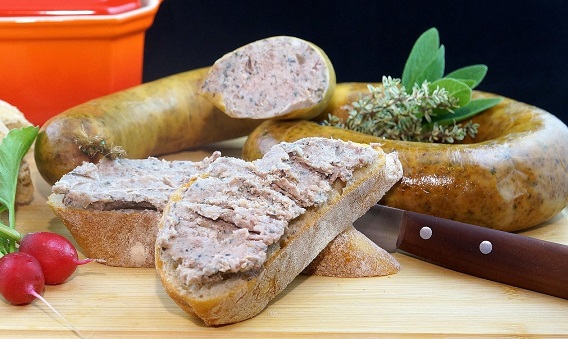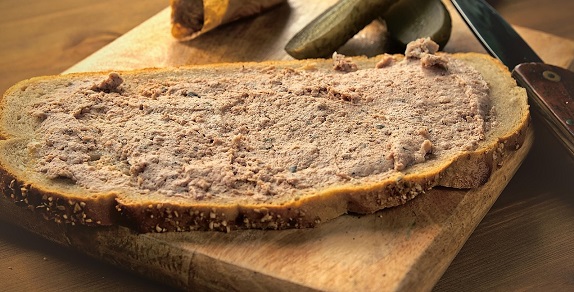
Say “Leberwurst” to a German, and chances are their mouth will start watering. This liver sausage has been a staple of German cuisine for centuries – savory, rich, and wildly versatile. Spread on bread, scooped onto rye crackers, or sliced and pan-fried, Leberwurst is as common in German households as peanut butter is in American ones.
In this article, we dive into the different types of Leberwurst, how they’re made, how to serve them, and even a classic homemade recipe for the daring cook. Whether you’re already a fan or just curious, this guide gives you the full picture of Germany’s iconic liver sausage.
What Is Leberwurst?
Leberwurst (literally “liver sausage”) is a spreadable sausage made from liver, pork, and spices. It comes in many varieties – some are smoked, others are smooth and pâté-like, while some are chunky and coarsely ground.
Leberwurst is usually cooked and ready to eat, often sold in casings, jars, or tins. It’s especially popular in German breakfasts, snack boards, and rustic Abendbrot (evening bread) meals.
Despite its humble ingredients, Leberwurst holds a gourmet status in German culinary culture thanks to regional pride and carefully guarded family recipes.
Types of German Leberwurst
There’s no single “true” Leberwurst in Germany – instead, each region offers its own twist. Here are some of the most common types:
1. Feine Leberwurst (Fine Liver Sausage)
- Smooth, spreadable texture
- Delicate seasoning (often with marjoram, white pepper, nutmeg)
- Ideal on rye bread or crispbread
2. Grobe Leberwurst (Coarse Liver Sausage)
- Chunkier texture with visible meat bits
- More rustic and filling
- Often used in hearty sandwiches
3. Bauernleberwurst (Farmer’s Leberwurst)
- Strong, smoky flavor
- Heavily seasoned
- May include garlic, allspice, and onion
4. Thüringer Leberwurst
- Protected regional specialty
- Creamy but rich in spices like marjoram and coriander
- Often eaten warm with potatoes or kraut
5. Pfälzer Leberwurst (Palatinate Style)
- Smoky, dark, and intensely flavored
- Usually eaten warm or pan-fried
- Frequently paired with sauerkraut
Ingredients in Traditional Leberwurst
Though recipes vary, most include:
- Pork liver (30–40%)
- Pork belly or fatback
- Onion
- Salt and pepper
- Marjoram, thyme, nutmeg, and/or allspice
- Optional: garlic, coriander, mustard seed, or cream
Most types are fully cooked and pasteurized, making them shelf-stable or ready to eat straight from the jar.
How to Make Traditional Leberwurst
Note: Making Leberwurst at home requires some basic sausage-making tools – like a meat grinder, sausage stuffer, and casings. Alternatively, you can store it in jars.
Ingredients (for about 1.5 kg of sausage)
- 500 g pork liver
- 700 g pork belly or shoulder
- 300 g pork fatback
- 2 small onions
- 15 g salt
- 3 g ground white pepper
- 2 g marjoram
- Optional: pinch of nutmeg and garlic
Instructions
- Prep the meat: Cut liver, pork, and fat into small chunks. Chill well.
- Cook the meat: Simmer liver and pork in lightly salted water until cooked through (about 30 minutes). Do not boil vigorously.
- Grind: Pass everything through a meat grinder. For smoother texture, grind twice or use a food processor.
- Mix and season: Add spices and onion (lightly sautéed or cooked with the meat). Mix until uniform.
- Stuff into casings or jars.
- Cook again: Gently simmer filled casings or jars in hot water (around 80°C) for 60–90 minutes depending on size.
- Cool and refrigerate. Keeps for about 1 week in the fridge or longer if vacuum-sealed and frozen.
How to Serve Leberwurst

Leberwurst is traditionally eaten cold as a spread:
- On rye bread or pumpernickel
- Topped with pickles, mustard, or onions
- As part of a Brotzeit platter with cheeses, radishes, and cold cuts
Hot Serving Suggestions:
- Sauté slices and serve with mashed potatoes
- Fold into scrambled eggs for a savory breakfast
- Melted over fried potatoes as a hearty snack
It also works as a rich filling in Savoy cabbage rolls or even savory pastries.
Storage Tips
- Keep Leberwurst refrigerated and use within 7 days once opened
- Freeze unused portions in airtight containers
- Homemade Leberwurst should be consumed sooner unless pressure-canned
Regional Leberwurst Specialties Worth Trying
- Frankfurter Leberwurst – slightly smoked with creamy texture
- Rheinische Leberwurst – tangy, sometimes with vinegar
- Sächsische Leberwurst – mildly spiced with fine consistency
You’ll find that every butcher in Germany adds their signature twist.
Health Note
While Leberwurst is high in iron and vitamin A, it’s also high in fat and cholesterol – making it more of an occasional treat than a daily staple.
Leberwurst Fun Facts
- Leberwurst dates back to the Middle Ages, originally used to preserve offal.
- In some parts of Germany, kids grow up eating Leberwurst sandwiches in their lunchboxes.
- It’s even become a term of endearment or mock insult: “Du bist eine beleidigte Leberwurst” = “Don’t be such a sulky sausage!”
Leberwurst may sound intimidating to some, but it’s one of Germany’s most treasured comfort foods. Whether enjoyed on fresh Bauernbrot or used as a savory ingredient, this liver sausage delivers rich, authentic flavor with every bite.
Try different regional varieties, or make your own – and taste a slice of German culinary tradition.
Related Articles:
12 Types of German Wurst You Should Know
From Bratwurst to Blutwurst, this guide introduces 12 of Germany’s most iconic sausages. Learn what makes each one unique – and how to cook or serve them.
What Is Landjäger? Germany’s Hiking Sausage Explained
Find out why Landjäger is Germany’s go-to snack for hikers. Learn how it’s made, how to store it, and what makes it perfect for outdoor adventures.
What Is Mettwurst? Raw-Cured German Sausage Guide
Dive into the world of Mettwurst – a cured, often smoked raw sausage. Discover its regional styles, how to enjoy it safely, and what makes it different from Mett.
What Is Knackwurst? Germany’s Snappy Sausage Explained
Learn all about Knackwurst – the garlicky, juicy sausage that snaps when you bite. See how it’s made and served across Germany.
What Is Bockwurst? Mild German Sausage Explained
Bockwurst is Germany’s mild, family-friendly sausage. Find out why it’s beloved by all ages and how to poach and serve it the right way.
What Is Blutwurst? Traditional German Blood Sausage
Blutwurst is Germany’s traditional blood sausage – rich, hearty, and historic. Learn how it’s made, regional styles, and how to cook or enjoy it cold.
Nürnberger Rostbratwurst – Recipe and History
Explore the legacy of Nürnberger Rostbratwurst – the small sausage with big flavor. Includes authentic preparation methods and cultural background.
The Best Homemade Currywurst Recipe
Make authentic Berlin-style Currywurst at home with this easy recipe. Includes sausage prep, homemade curry ketchup, and street food-style serving tips.
Frankfurter Würstchen – The Original German Hot Dog
Discover the authentic Frankfurter Würstchen – Germany’s original hot dog. Learn its history, protected status, and how to heat and serve it the traditional way.
Teewurst – Soft German Sausage for Spreading
Explore Teewurst, the smoky, spreadable sausage originally served at tea time. Find out how it’s made, stored, and delicious ways to enjoy it at home.
How to Make Traditional German Bratwurst at Home
This detailed recipe guide walks you through making real German Bratwurst from scratch – with tips on ingredients, grinding, stuffing, and grilling.







